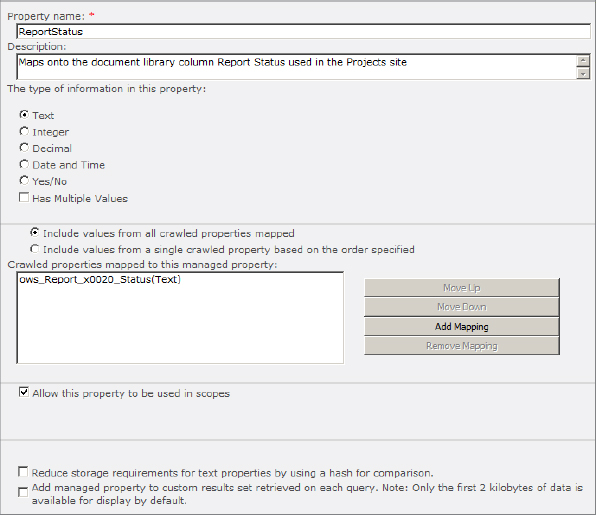Create Metadata Property Mappings
One of SharePoint’s strongest features is the ability to associate metadata (properties) with documents, images, and list items in order to organize the information for a business. Business users use this metadata to sort and filter large numbers of items into more meaningful subsets. Search takes advantage of the same metadata to locate and return relevant results. All metadata attributes found either on a document (as embedded attributes) or associated with an item (as a custom column in the list or library) are indexed by SharePoint. All metadata values are used by SharePoint when it performs a search query. Thus, results will be returned where the keyword was found in a property rather than the text of the document. Many of the properties discovered by SharePoint use names that do not accurately reflect their purpose (e.g., Office:4 is a property that holds the Author value).
To make the crawled properties more usable and to provide a common name for multiple properties, SharePoint ties metadata properties together into managed properties, which serve as aliases for the crawled properties. Managed properties can be used explicitly to configure the property-based searching in the search center sites.
To view the managed properties, from within the Search Service Administration site, under Queries And Results, click the Metadata Properties link, which will open the Metadata Property Mappings page, shown in Figure 9.9.
Figure 9.9: Metadata Property Mappings page

Viewing Crawled Properties
SharePoint maintains a catalog of all the metadata properties discovered during indexing. Many of the properties are drawn from Office files and are categorized as such. Others represent SharePoint columns that have been crawled and can be seen as those that have the prefix ows_ and are encoded to replace spaces and other illegal characters. For example, the custom SharePoint column Report Status would be listed under crawled properties as ows_Report_x0020_Status(Text).
This catalog of crawled properties can be viewed by clicking the Crawled Properties link on the Metadata Property Mappings page.
Creating a New Managed Property
Only a few of the crawled properties are mapped onto managed properties that are used by SharePoint. Under most circumstances, the best practice is to not modify any of the existing managed properties installed with SharePoint. Instead, it is often useful to create new managed properties to map onto new crawled properties that correspond to business data that needs to be searched. For example, a document library may have been configured with a column named Report Status that holds values such as Reviewed that users want to search on without getting every document in SharePoint that contains the word. To create a managed property, do the following:
1. From within the Search Service Administration site, under Queries And Results, click the Metadata Properties link, which will open the New Managed Property page. This page with completed fields for a new property is shown partially in Figure 9.10.
Figure 9.10: New Managed Property page

2. In the Property Name field, enter a name for the new property, leaving out spaces between any words. Optionally, enter a description of the property.
3. Select the data type of the property and whether or not it will contain multiple values that need to be split.
4. In the Mappings To Crawled Properties section, click the Add Mapping button.
5. In the Crawled Property Selection dialog box, enter a portion of the column name or property you are mapping onto and click Find or browse the list to find the property. Select the property and click OK.
If the property you are looking for does not appear, then it may be necessary to conduct a Full Crawl to let SharePoint discover it.
6. If you want to use this property in the rule of a shared scope, select the check box Allow This Property To Be Used In Scopes. (See the section “Understanding Scope Rules” earlier in this chapter for more information.)
7. Optionally, check the boxes labeled “Reduce storage requirements for text properties by using a hash for comparison” or “Add managed property to custom results set retrieved on each query.”
8. Click OK.
NOTE To get results from the new property in a custom scope, you will need to perform a Full Crawl to incorporate the new mapping into the index.
